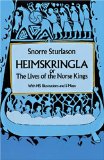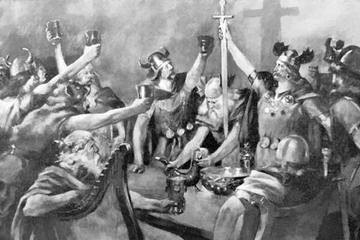|
Old Norse YuleIn chapter 55 of the Prose Edda book Skáldskaparmál, different names for the gods are given. One of the names provided is "Yule-beings." A work by the skald Eyvindr skáldaspillir that uses the term is then quoted, which reads: Again we have produced Yule-being's feast [mead of poetry], our rulers' eulogy, like a bridge of masonry. Ynglinga saga, the first book of Heimskringla, first mentions a Yule feast in 840. After 1000, it is the main feast of the year.[6] Saga of Hákon the Good credits King Haakon I of Norway with the Christianization of Norway, as well as rescheduling the date of Yule to coincide with Christian celebrations held at the time. The saga states that when Haakon arrived in Norway he was confirmed a Christian, but since the land was still altogether heathen and they retained their practices, Haakon hid his Christianity to receive the help of "great chieftains." In time, Haakon had a law passed that established that Yule celebrations were to take place at the same time as when the Christians held their celebrations, "and at that time everyone was to have ale for the celebration with a measure of grain, or else pay fines, and had to keep the holiday while the ale lasted."
Old Norse Yule Haakon spent most of this time in Trondheim, Norway. When Haakon figured that he wielded enough power, he requested a bishop and other priests from England, and they came to Norway. Upon their arrival, "Haakon made it known that he would have the gospel preached in the whole country." The saga continues describing the reactions of various regional things as they differ the matter to one another. A description of "heathen" Yule practices is provided (notes are Hollander's own): 
Old Norse Yule - from the Sagas Few topics might have a less boring promise to them than a a dreary, commented narration of the deeds of long-dead monarchs. But, as it happens, in the skilful hands of that remote, enigmatic figure that was Snorre Sturlason, this compendium becomes a thrilling subject likely to satisfy the mind of the professional historian and thirst for adventure of the young, budding intellectual turk. Mr. Sturlason is indeed a kind of mysterious figure. Icelandic by birth, he would no doubt feel at home in the world of modern politics; as a matter of fact, he might have one or two things to teach any well seasoned contemporary politician. Why he devoted his life to political scheming and Norse history, we shall never know for sure; but should be under no illusion about his prowess in both disciplines. He's no doubt the Herodotus of the northern latitudes - and the Machiavelli. Nonetheless, in analogy to other historical figures, he machinated and intrigued a bit too far, which brought him his demise, after an anyway rather long life. At the thirteenth century, the historical framework that saw the flourishing of Snorre Sturlason, the dynasties of Norwegian kings have come to an end. Not surprisingly so though, due to the extreme bellicosity and, from our late twentieth century point of view, hooligan-like features that characterized that string of monarchs. Snorre's tale starts at the mythical times of the creation of the world, eons ago, with a crisp narrative of the well-known old Norse cosmology. It is not clear where mythology terminates and history begins, and one cannot help but wondering if the scheming historian kept the ambiguity on purpose. At any rate, Snorre's prose flows easily and leads the reader deep into the old Norse world and customs, everyday life, nonchalantly describing grim, sometimes gruesome deeds, bringing us back to a period in which the conception of the world, ethics, morality and existence itself, were vastly different from ours in the West. The reader will no doubt be captured by the relentless, powerful sense of revenge implicit in the death of a Scottish chieftain, who succumbed to infection that set in due to the injuries done to his leg by the teeth of the head of a Norse invader, that he had cut off and tied up to this horse's saddle as a victory trophy; or by the moving, and the same time horrific, reaction of king Harald the Fairhaired at the death of his favourite lover Snaefrid, the details of which we leave for the inquisitive reader to discover. A milestone in the world literature and history, the Heimskringla will leave no one unmoved, and will surely expand the vision of many.
It was ancient custom that when sacrifice was to be made, all farmers were to come to the heathen temple and bring along with them the food they needed while the feast lasted. At this feast all were to take part of the drinking of ale. Also all kinds of livestock were killed in connection with it, horses also; and all the blood from them was called hlaut [ sacrificial blood ], and hlautbolli, the vessel holding the blood; and hlautteinar, the sacrificial twigs [aspergills]. These were fashioned like sprinklers, and with them were to be smeared all over with blood the pedestals of the idols and also the walls of the temple within and without; and likewise the men present were to be sprinkled with blood. But the meat of the animals was to be boiled and served as food at the banquet. Fires were to be lighted in the middle of the temple floor, and kettles hung over them. The sacrificial beaker was to be borne around the fire, and he who made the feast and was chieftain, was to bless the beaker as well as all the sacrificial meat. The narrative continues that toasts were to be drunk. The first toast was to be drunk to Odin "for victory and power to the king", the second to the gods Njörðr and Freyr "for good harvests and for peace", and thirdly a beaker was to be drunk to the king himself. In addition, toasts were drunk to the memory of departed kinsfolk. This toast was called "minni [memorial toast]". Old Norse Yule The Svarfdæla saga records a story in which a berserker put off a duel until three days after Yule to honor the sanctity of the holiday. The Grettis Saga refers to Yule as a time of "greatest mirth and joyance among men." This saga is set soon after Iceland converted to Christianity and identifies Yule with Christmas: "No Christian man is wont to eat meat this day [Yule Eve], because that on the morrow is the first day of Yule," says she, "wherefore must men first fast today."
Old Norse Yule Home page  Custom Search
|

